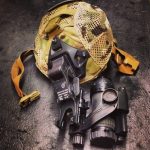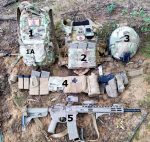This is a follow-up contribution to the two gear posts: The Practical Application of Tactical Gear, Load, and Weight Considerations and Gear System: Philosophy, Set Up, Use, Fitness & Mindset. And as such, it should be read in combination with those posts. Notice that I have updated the gear photo from the one that I used in those posts.
There is not a huge difference between the gear displayed. There’s merely a different rifle and Lite Hydration Pack, plus I have added the helmet to the mix for purposes to be explained below. This illustrates the point that this post is not about specific brands of gear but rather the MVT Lite Fight concept that I have been advocating in these various blog posts.
It’s in the Details
In this post, I will be making some detailed comments. This post is specifically about putting all this gear together for wear during combat conditions. We won’t be able to cover the ground in detail about how you will escalate, or combine, or choose items of gear to escalate your everyday carry as a response to increased threats. That was covered in detail in the two linked posts above. This post is about putting this MVT Lite Fight concept together when the threat is extant, we are conducting combat operations, the hammer already dropped, the balloon went up, and there are possibly bad guys in the wire. You are conducting active home base defense/ground domination activity. This does not mean you lose all flexibility. You still have the option of combining or dropping items, depending on the mission, terrain, duration, distance, and weather.
Items Used in the MVT Lite Fight Concept
The MVT Lite Fight Concept consists of the following, numbered in the photo:
- Lite Hydration Pack (LHP).
- Plate Carrier (PC).
- (Helmet).
- Lite Battle Belt (LBB).
- Rifle
When To Wear This Gear
All this gear put together should be both the maximum and the minimum that you would expect to carry on any operation away from your home where there is any chance of contact with the enemy. This means any operation “out of sight” of your home base and any patrol where you are not literally within a 100 yards or so of that home base. If you are at home base, then you can choose what you will wear i.e. what elements of the system.
There is nuance and reality to add to this, which I will discuss below. Please remember the premise: we are now in “combat conditions”. However, reality will play a role, and you will have to adjust your profile depending on the exact specifics of the mission you are on. Bartering at the local farmers marker, for example, will likely see a de-escalation of this combat profile, and you will leave gear in the vehicles.
Yes, you will look like a soldier in this gear. It does not have to be multicam. However, the bottom line is that if you are conducting combat operations, you need to be equipped as a light infantryman.
Second Lines
One of the main drives of this concept is to carry enough to be effective but not so much that you become ineffective. Refer to the previous posts for discussion of second line ammunition and ration/water logistical scales on support vehicles. There is a balance of strength and fitness versus weight, and depending on your limitations you may have to adapt this concept to suit. That will be discussed below in the detail.
Physical Fitness Required for Infantry Combat Role
You do, however, have to do whatever physical conditioning you are able to handle, if you are considering a light infantry combat role. If you are prevented from carrying the minimum of this gear by age or physical condition, then you should look to a support role, situated out of the home base where you can contribute to security by standing watch and being part of the static defense team. You are likely to be able to primarily contribute in areas other than security in a considerable manner, depending on your skills and attributes.
For those who are equipped in this manner they need to be physically conditioned to be able to maneuver under enemy fire. They must be trained and rehearsed in team tactics. You cannot run this type of thing with a pick-up team, if you want to stand any chance at all. This is all a balance between firepower, mobility, and protection. There is no perfect solution.
BALANCE: FIREPOWER – PROTECTION – MOBILITY
The Detail:
(1) Lite Hydration Pack (LHP):
- This should be a small pack that includes a water bladder (2-3 liters). It should not exceed more than 15 liters of capacity for the pack. Any more than that and your gear total will make you unable to maneuver effectively under effective enemy fire.
- You must resist the temptation to keep packing this, and going bigger with this pack. It will be frustrating, and you will want to put more in, just in case. Just put it on and consider if, with this gear load, you can maneuver under enemy fire. That is your benchmark.
- Do not forget the need for some sort of logistic chain or support network, either at the home base or forward mounted in vehicles.
- This is not a “ruck” and you are not going overnight. What missions are you planning? This is merely an expanded hydration pack with room for some essentials. You should be able to go for 24 hours in this pack; mostly, you will be out for a few hours local patrolling. In the summer, you will be hot and sweaty. In the winter, you will start the patrol cold and have basic snivel/rain gear for survival, if you go static.
- If you are moving in vehicles, this pack becomes your grab bag.
- If you get into contact, you will need ammo resupply and potentially casualty evacuation. You will need a Quick Reaction Force (QRF) equipped with some sort of vehicle and communications with them.
Some Options For What You Should Include in the LHP
The following items can go in your Lite Hydration Pack, or you may place them elsewhere:
- Hydration bladder.
- Water purification tabs, straw, pump, or means to fill/drink more water than you have in the bladder.
- Basic weapon cleaning kit, lube (SLIP 2000), spares, including rod to remove stuck cases.
- Emergency energy bars.
- Packed meal or energy source for duration of patrol.
- Basic gear for layering– your ”snivel gear”. You will be able to fit, for example, a rain jacket in there plus a cap and gloves.
- Night vision gear. (Note: There is more on this below.)
- FLIR Thermal. You can mount the FLIR on your gear or fit it in your pack.
- Batteries for radio and night vision.
- Magazines. There are single magazines in pouches on each side of the pictured pack for a total of two.
- Basic “boo-boo” first aid kit (very small pouch) with any meds needed and anti-inflammatory (i.e. Aleve or naproxin).
- Pouch 1A on the photo contains a “Crye Nightcap”, which replaces a helmet for PVS 14 head mounting.
 Photo: Crye Nightcap with PVS14 mounted.
Photo: Crye Nightcap with PVS14 mounted.
(2) Plate Carrier.
There are a number of notes on the Plate carrier (PC):
- You should wear ballistic plates in a kinetic combat environment.
- You should invest in ceramic/hybrid “Level 3 plus” lightweight plates. This is an investment in mobility while retaining protection.
- If you cannot maneuver with the weight of the plates and the rest of your gear, then do not use them. This is a function of your conditioning level. You have to do the PT to be able to wear the plates.
- Be careful when rigging your PC to ensure that you do not go overboard with the weight. The PC (2) in the photo is a modified Crye JPC with kydex in the front mag pouches to fit 3 x magazines. There is basically no other gear on it.
- Noted in (2A) on each side of the magazines are Crye radio pouches which will also take up to 2 x magazines. This is a similar concept to the 2 x side pouches on the MVT SOR chest rig (not currently in production). This gives you the option for additional gear on the PC, such as radio, additional magazines, or to stow a FLIR Thermal to hand.
- You can replace the PC with a chest rig. This is a personal decision based on your purchasing criteria and physical conditioning relative to ballistic plates.
- You can wear a chest rig over a slick PC, using the chest rig straps, or you can use a PC attachment kit to mount a chest rig directly to the slick PC. These are all mounting options which give you flexibility, and allow you the decision on a case by case basis to wear the PC, or not.
- There is no perfect solution to the balance of weight versus conditioning versus operational capability. You have to carry some gear to be effective on the ground as a dismounted infantryman. But you cannot carry too much or it will render you ineffective.
In Part 2, I’ll continue with more information about plates, including some of the “tomfoolery” ideas about them and also the ergonomics issues with them. Then, we’ll move on to other components of the MVT Lite Flight Concept and wrap up this post series.
About The Author
Max Alexander is a tactical trainer and author. He is a lifelong professional soldier with extensive military experience. He served with British Special Operations Forces, both enlisted and as a commissioned officer; a graduate of the Royal Military Academy Sandhurst. Max served on numerous operational deployments, and also served as a recruit instructor. Max spent five years serving as a paramilitary contractor in both Iraq and Afghanistan. This included working on contract for the U.S. Government in Iraq, a year of which was based out of Fallujah, and also two years working for the British Government in Helmand Province, Afghanistan. He operates Max Velocity Tactical (MVT).












Is there suspenders of some sort ? Or did I miss them? With just a few mags and a handgun and water bottle I always need suspenders. I don’t like the belt riding low while sprinting to cover. I use a nylon Vietnam issue with my new Blackhawk LBB a little Para cord helps out, and has not failed yet. I also find that having a belt not so tight around the waist helps my lower back NOT hurt at the end of the mission.
30 years ago I tried the “everything twice including the kitchen sink” gear packing approach. We quickly found out when we started ACTUALLY TRAINING that this approach was not feasible, even for young in shape people. My fear is that since most “preppers” don’t actually train, most will not find this out till it’s too late.
Good article, thanks
Exellent series Max! Keep’em coming.